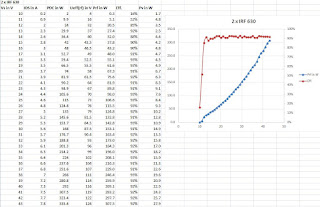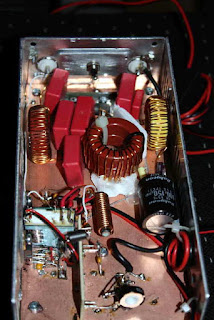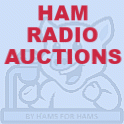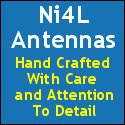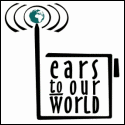Posts Tagged ‘630m’
 Another New VE on 630m!
Another New VE on 630m!
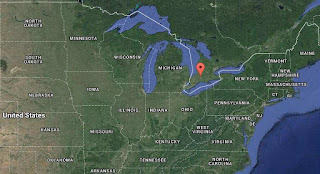 |
| courtesy: https://www.google.ca/maps |
Another new Canadian station has been activated on 630m ... VE3OT, Mitch, in London, Ontario.
For many years, Mitch has been running his QRSS 'MP' beacon on 2200m, using a large E-W wire loop and about 200 watts.
The move to 630m uses the same transmitter with a retuned loop and new output LPF. Although the antenna tuner still needs a capacitor swap and a new toroid to perfectly resonate the loop, Mitch has been getting many good 'audible' reports from eastern stations as well as from the central states and as far south as Texas.
Present testing is in the QRSS6 CW mode on 475.0 kHz. Unfortunately, since moving up to 630m, E-W propagation has been hit and miss and although I can copy his QRSS6 CW signal, I have not had aural copy as of yet ... maybe tonight.
 |
| courtesy: http://www.solarham.net/ |
***************************************************
Another 630m CW crossband activity has been planned for early February and I will have more details shortly. If you missed the last event, here is another chance to get in on the two-way crossband fun ... please stay tuned!
***************************************************
 GW3UEP 630m Transmitter Tweaks
GW3UEP 630m Transmitter Tweaks
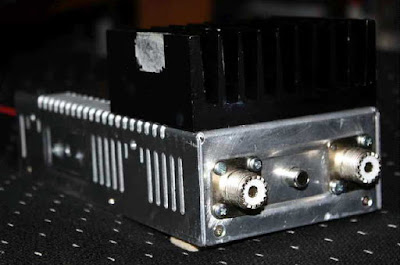 |
| DF8UO's GW3UEP 630m Tx |
Hi Steve,
I have seen on your Website, that you are also a MF/LF fan and builder of GW3UEP QTX. I build the version with 2 IRF540 as you proposed and the same version with 2 IRF630. As I bought some time ago a PSU with can be regulated from 1V to 60V and max 10A (it is a Manson HCS 3404) I made some measurements on both version. Find attached an Excel with the measurements I made, if you are interested in.
If you use the IRF540 version you can see that if the power exceeds 100 W, the efficiency goes down, as the IRF540 is only specified for 100V.
Currently I am using the IRF630 version running at 300W without problems.
From Daniel's test data, it looks as though the IRF540's are quite happy as long as you keep the transmitter at 100W or less ... anything higher would certainly benefit from the switch to IRF630's as the high efficiency is maintained at least to the 300W level. Something at this level would no doubt benefit from higher-voltage capacitors and heavier inductors as well as a little more heatsinking, enough to shed at least 25 watts of heat between the two FETs.
Daniel drives his amplifier with an Ultimate3, followed by a 10db attenuator, a squarer and into the totem pole driver stage. His own version uses toroidal inductors rather than the original air wound coils.
A pair of GW3UEP amplifiers using IRF630's at ~40V into a small power combiner, should provide ~550W of useful output at >90% efficiency ... more than enough power to do some serious work on 630m.
 More Low Noise Vertical (LNV) Construction
More Low Noise Vertical (LNV) Construction
 |
| New LNV At WG2XKA |
The low-noise vertical discussed here previously, has recently been implemented by at least three of the 630m experimental stations. John, WG2XKA / WA3ETD, along with Ken, WG2XXM / K5DNL and John, WG2XIQ / KB5NJD, have all constructed versions of this receiving antenna after reading about the details here.
John's antenna, pictured above, is described in more detail here, along with some nice pictures of his matching transformer.
All stations report good results with the antenna so it may be something you might want to consider if your present receiving antenna is a noise-collector.
For those interested in getting started on 630m, John (WG2XIQ), has a ton of inspiring information available on his website here as does John (WG2XKA) on his site here.
 630m WSPR
630m WSPR
 |
| courtesy: http://wsprnet.org/ |
Happy Thanksgiving to those of you in the U.S.A.
It seems that the 630m WSPR digital crowd is growing quickly, with more new stations showing up every evening on the web's WSPRnet activity page. Most nights see activity from 80 or more stations, either transmitting or listening in WSPR mode on 630m!
WSPR is the 'Weak Signal Propagation Reporter' beacon-only mode being used by many of the stations presently transmitting on 630m, especially the U.S. experimental stations.
Those with the WSPR software (freeware and easily installed) usually have the program automatically upload their spots (stations being heard) to the WSPRnet page so that the transmitting stations are able to see where their signals are being heard. It also becomes quickly apparent, when examining the various spots, just how good or bad propagation might be at any given time.
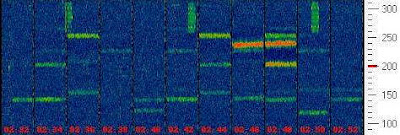 |
| WSPR Waterfall Displaying Detected Signals |
If you choose, you can also see your spotted stations in a Map mode, as shown at the top. This map shows the stations that I was hearing last night on 630m.
Along with the call and grid locator of the station being heard, the WSPR software also indicates several other bits of information, including the signal-to-noise ratio as heard at your location. Shown below is the decoded output from several stations following the two-minute transmission period.
| 06:58 | WH2XXP | 0.475662 | -13 | 0 | DM33 | 5 | VE7SL | CN88iu | 1909 | |
| 06:58 | WG2XXM | 0.475709 | -6 | 0 | EM15lj | 5 | VE7SL | CN88iu | 2610 | |
| 06:58 | WG2XKA | 0.475723 | -9 | 0 | FN33lq | 1 | VE7SL | CN88iu | 3833 |
Note the SNR reports ... usually, signals stronger than around -14dB will be just detectable by ear with anything in the + range being pretty strong.
Shown below are the Tuesday night reports of local station, VE7CNF, and indicates the extensive area over which his WSPR beacon was reported. Toby is running a modest 5W eirp station from a suburban-sized lot. Analyzing the reports, it is apparent that many of these stations rose to audible signal levels at various times throughout the evening and would have probably been workable on normal CW mode ... even from the 'burbs!
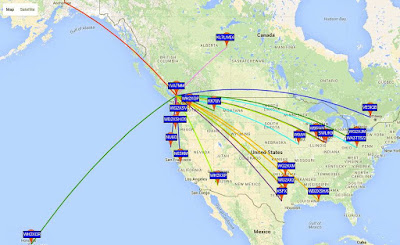 |
| courtesy: http://wsprnet.org/ |
There are probably many of you already listening to WSPR signals on HF and have yet to venture down to 630m to see what can be heard. The improved propagation conditions of late make this an ideal time to have a peek at 630m and see what you can spot.
Your low-band wire antennas can often hear surprisingly well below the broadcast band and you may be surprised at what WSPR can detect. Use the USB mode with your receiver set to 474.200 kHz and, if possible, upload your 630m MF spots to the WSPRnet. You can also follow up-to-the-minute activity on the 2200m/630m ON4KST Chat page which is always interesting.
 630 Crossband Excitement
630 Crossband Excitement

In spite of the mediocre band conditions, this past weekend's 630 crossband activity was a great success. Firstly, it was gratifying to see so much activity from the VE7 region. Last year, it was just John, VE7BDQ, and myself, holding the fort, but this year saw new activity from VE7CNF, VA7MM and VE7CA. If this rate keeps up, the band will soon be getting crowded and wouldn't that be great!
It was only a few short months ago that VE7CNF and VA7MM began tinkering on 630m, their signals barely out of the noise here on Mayne Island. How quickly their stations have evolved into systems now capable of working several thousands of miles on the new band. To make the weekend even more special, Markus, VE7CA, had his first-ever 630m contacts on Saturday, working all of the locals and later in the evening, pushing his 14 watts down into Tahuya, WA, working K7CW on crossband. I'll wager that Markus will treasure that first 'DX' QSO for some time.
Conditions from VE7 on Friday were poor, and although somewhat disappointing, not entirely unexpected after watching the sun play tricks on our geomagnetic field all week long. The only path that seemed somewhat normal was the north-south one, yielding contacts with the Californians. As the K-index briefly dropped to '1', Saturday's conditions were much improved, showing short-lived glimpses of normality both to the west and to the east.
On both evenings, the HF bands (and probably 630m to a lesser extent) seemed to be very 'long', with few continental signals being heard. The long skip made it very hard, in some cases, to hear close-in callers on both 40 and 80m ... callers who would normally be 599. Particularly absent where callers from the closer WØ states and the easier W7 regions such as Nevada, Utah and Arizona ... areas that have been easily worked on previous crossband nights. It was also disappointing to not have anyone from the other VE regions call in. I hope it was just conditions and not from lack of trying, as it has been a struggle to generate much interest in the western provinces so far.
The biggest surprise and the highlight of the weekend was most assuredly the crossband contacts between the VE7 stations and Hawaii, with VA7MM, VE7CNF, VE7BDQ and VE7SL, all working Merv, K9FD/KH6 in Maunaloa on Moloka'i Island. Merv noted that all four VE7's were worked within a 25 minute window and all peaked at different times. A few minutes later, the 'tranpacific' path turned 'transcontinental' as NO3M in Pennsylvania, called VE7SL and exchanged 559/549 signal reports ... who would have thought that 630m could generate such magic! This band has so much exciting potential for amateurs, even for those confined to normal suburban backyard locations. Activity will surely skyrocket when U.S. amateurs get access to the band ... hopefully soon.
Several SWL reports were received from the U.S., with one of the most interesting coming on Saturday night, from the maritime operators at KSM, near San Francisco. As well, the Red Oak Victory shipboard station anchored near San Francisco, KYVM, sent a detailed report of several VE7 stations that they had heard.
Crossband Summaries
VE7BDQ :
VA7TA CN79 Courtenay, BC
K6LG DM13 Riverside, CA
VA7MM CN89 Port Coquitlam, BC
VE7KW CN89 Port Coquitlam, BC
K7HV CN87 Seattle, WA
VE7CA CN89 North Vancouver, BC
VE7CNF CN89 Burnaby, BC
VE7SL CN88 Mayne Island, BC
K7CW CN87 Tahuya, WA
VA7JX CN79 Campbell River, BC
VA7DXX CN89 Ladysmith, BC
K9FD/KH6 BL11 Maunaloa, HI
K7SS CN87 Seattle, WA
K6AIG DM04 Mandalay Bay, CA
VE7CNF :
KK7UV DN36 Missoula, MT
VA7MM CN87 Port Coquitlam, BC
K6GZ DM14 Esperia, CA
VA7TA CN79 Courtenay, BC
K6LG DM13 Riverside, CA
K7CW CN87 Tahuya, WA
VE7KW CN89 Port Coquitlam, BC
VE7BDQ CN89 Delta, BC
VA7DXX CN89 Ladysmith, BC
WØYSE CN85 Vancouver, WA
K9FD/KH6 BL11 Maunaloa, HI
VA7MM :
VE7KW CN89 Port Coquitlam, BC
VA7TA CN79 Courtenay, BC
K7CW CN87 Tahuya, WA
K9FD/KH6 BP11 Maunaloa, HI
WØYSE CN85 Vancouver, WA
K7SS CN87 Seattle, WA
VA7DXX CN88 Ladysmith, BC
VE7CA :
VE7SL CN88 Mayne Island, BC
VE7CNF CN89 Burnaby, BC
VE7BDQ CN89 Delta, BC
K7CW CN87 Tahuya, WA
VA7MM CN87 Port Coquitlam, BC
VO1NA :
VE1VDM FN85 Onslow, NS
VO1BQ GN37 St. John's, NL
VE7SL :
VE7KW CN89 Port Coquitlam, BC
KK7UV DN36 Missoula, MT
VA7MM CN87 Port Coquitlam, BC
K6GZ DM14 Esperia, CA
VA7TA CN79 Courtenay, BC
K7CW CN87 Tahuya, WA
K6LG DM13 Riverside, CA
VE7BDQ CN89 Delta, BC
VA7DXX CN88 Ladysmith, BC
VA7JX CN79 Campbell River, BC
K9FD/KH6 BP11 Maunaloa, HI
NO3M EN91 Saegertown, PA
K7SF CN85 Portland, OR
K7SS CN87 Seattle, WA
KGØD/7 CN88 Sequim, WA
W2VJN CN83 Roseburg, OR
It is readily apparent that acres of antenna space are not needed to enjoy 630m ... all of these stations operate out of normal-sized residential lots, with antennas planned and built well enough to exploit the propagation characteristics of 630m.
 | ||
| VA7MM antenna system. More info here. |
| VE7CNF's homebrew PA. Website here. |
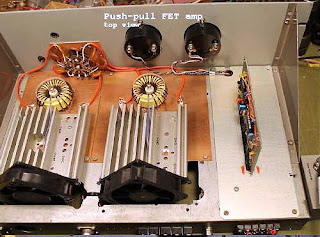 |
| VE7BDQ's homebrew 2200m/630m duo-band tx. |
 630m Crossband – Last Minute Addition
630m Crossband – Last Minute Addition
 Another VE7 has been added to the group of Canadians who will be active tonight and tomorrow night during the CW crossband activity.
Another VE7 has been added to the group of Canadians who will be active tonight and tomorrow night during the CW crossband activity.VE7CA will be operational during the evening on 475.5kHz. He will be listening for calls on both 3555kHz and 7064kHz. His hours of operation will be from 0300Z - 0500Z. This will be Markus's first operation on 630m and he would be delighted to work anybody that is able to hear him. He will be running ~ 25W output to a large top-loaded vertical, high on the hills of North Vancouver.
Please give a listen for him and make all of his hard work worthwhile!
 630m Crossband Reminder
630m Crossband Reminder

Just a reminder of the '630 activity event' ... including the crossband CW activity, tonight and tomorrow. The complete operating schedule, showing times and frequencies, can be viewed here.
The sun has been acting-up once again and band conditions have been up and down all week. Another CME is scheduled to arrive at anytime ... the jury is still out on how good or how poor the band might be.
More of a concern is the weather forecast. Very high winds are forecast for the west coast VE7 operators. I'm not worried about losing antennas but more likely, losing the hydro power, as often times the first big windstorm of the fall brings down a lot of branches and trees ... and that means power outages. So if you don't hear me, or some of the other stations, that may be the reason.
As well, please be patient if signals appear too weak, as the long slow fade-rate on 630m will often result in a huge change just a few minutes later.
If you can possibly give a listen for any of the crossband stations and respond to their CQ's it would be really great ... we hope to see as many of you as possible tonight or tomorrow, weather permitting!


